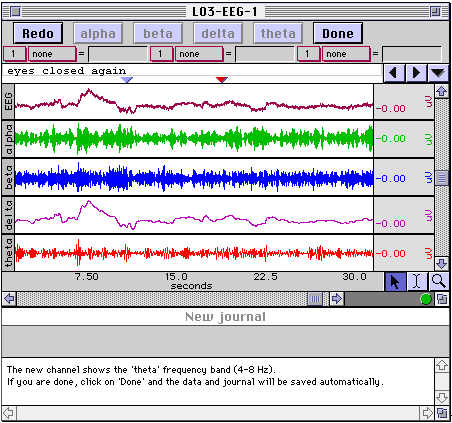Neurophysiology – Animal

Study EEG under a variety of conditions to explore relaxation and brain rhythms, software will filter and display each rhythm separately: alpha, beta, delta, and theta. Select from a variety of lessons to study alpha rhythms in the occipital lobe, reaction times, and hemispheric asymmetry. Add the EOG (occipital signal) to study eye movement, saccades, tracking, angular displacement, or ocular fixations. Use the stimulator to study evoked response: auditory, visual, or somatosensory. The new high-speed MP36 hardware allows for the recording of spontaneous nerve activity, continuously, at speeds of 100,000 samples a second. Add the SuperLab stimulus presentation package to perform remarkable psychophysiology stimulus/response protocols examining high-level brain activity. Conduct microelectrode recordings and study action potentials (human or animal). Conduct intracellular and extracellualr recordings with glass microelectrodes and Ag-AgCl wire electrodes to study action potentials from a variety of subjects.
Hardware
| Name | Description | Cart |
|---|---|---|
| High Impedance Cables | Micro-electrode interface cables for MP36/36R, MP35, MP30, or MP45* These fully-shielded, unity gain, high-impedance, differential input, electrode interface cables permit high resolution recording of biopotential signals. These interface cables incorporates dual ultra-high impedance buffer amplifiers (one for Vin+ and one for Vin-) to allow for connections to needle electrodes, wire electrodes, or very small surface electrodes… | $242.00Select options |
| Voltage Stimulators | The Voltage Stimulator connects to either the MP36/MP35 or the MP30. BNC output provides compatibility with a variety of stimulator cables. The voltage Range and Level are manually controlled while the pulse timing is user-adjustable and controlled by the Biopac Student Lab software. The Voltage Range (.025-10 Volts or .12-100 Volts) is established by a switch with… | |
| Stim Electrode, Human-safe | The Human-safe Stimulation Electrode HSTM01 provides a superior degree of safety and comfort when using a Voltage Stimulator for human stimulation. The ergonomic design allows the user to focus on the electrode placement instead of worrying about holding the electrode. Subjects depress the red safety switch to allow the software-controlled stimulus presentation through. To stop… | $308.00Add to cart |
| SuperLab System for MP36/35 or MP36R | The STP35W is a stand-alone system that measures subject responses to visual or auditory stimuli. Includes SuperLab current release, c-pod, and response box. SuperLab - present visual stimuli on a computer screen, or auditory stimuli via headphones or speakers, and simultaneously (1 ms resolution) send trigger signals for data synchronization and collection purposes to an… | |
| Low Voltage Stimulator, BSL MP35 | Use the low voltage stimulator with any electrode or lead with a BNC connector (such as needle electrodes or clip leads) for direct stimulation of animal or tissue preps. Control the stimulus with the Output Control option of the BSL PRO software. Monitor the output directly on the computer without any external cable. Interface options:… | $303.00Add to cart |
Stay Connected